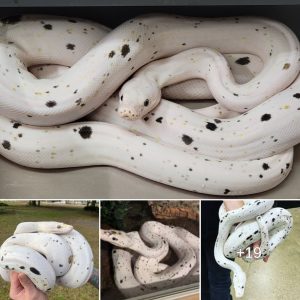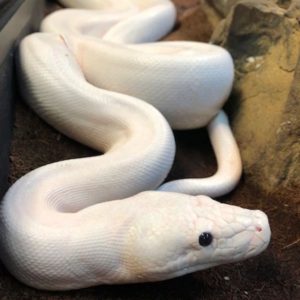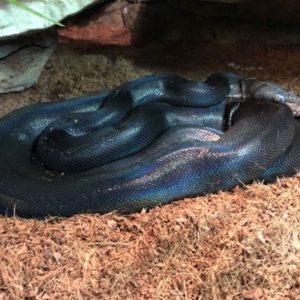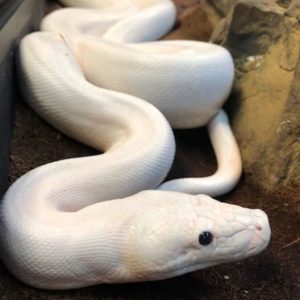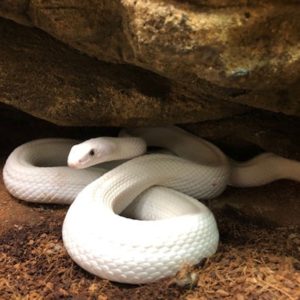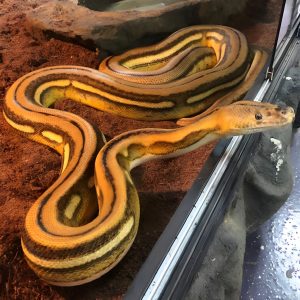The Blue Eyed Leucistic Ball Python is an amazing looking paper white snake with bright blue eyes.
Blue eyed leucistic ball pythons combine are desirable both in terms of their appearance and temperament. They are a striking pure white with gorgeous blue eyes, making them one of the most sought-after morph varieties.
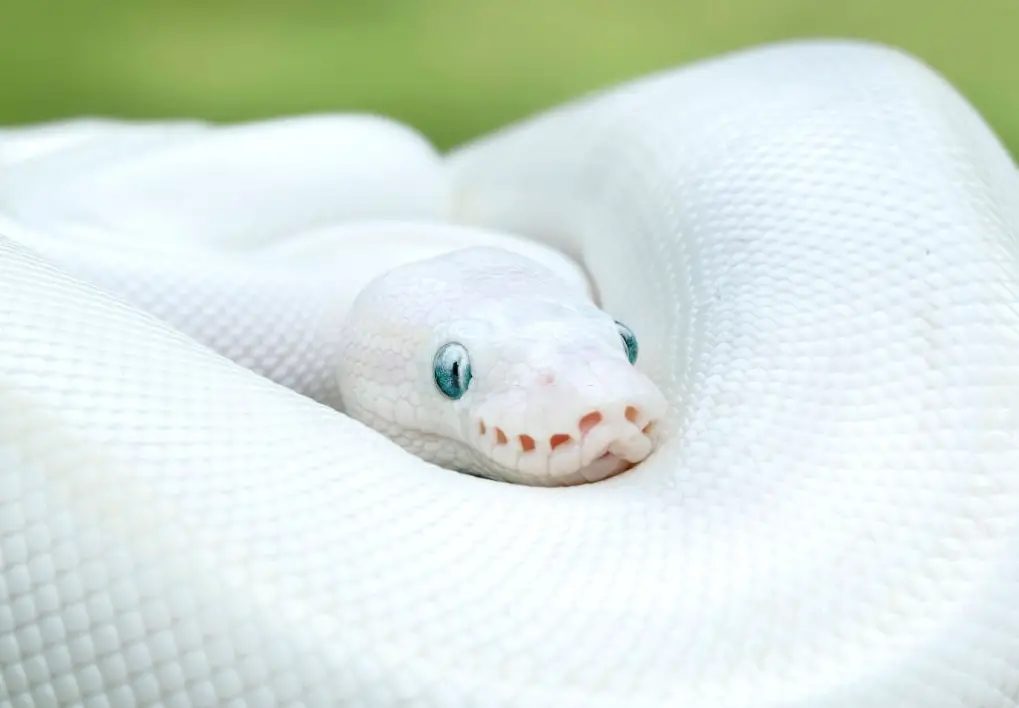
Keepers are also fond of this snake because of its docile nature and easy care. It has all the same care requirements of the traditional ball python and none of the health issues of many morphs, making it one of the best ball python options available.
Reptile Overview
The blue eyed leucistic ball python is stunning in appearance and handles well. Combined with its straightforward care requirements, this morph would make the perfect pet for keepers of all experience levels.
This snake grows up to 5 feet and lives up to 30 years, making it an easily-managed snake despite its long life.
Leucistic ball pythons need at least 40 gallons with three hides. Their enclosures should be 75 – 85 degrees Fahrenheit and have 50 – 60% humidity levels.
They need 24/7 access to fresh water and accept rodents (and occasionally birds) easily.
Appearance
Also known as a blue-eyed lucy or BEL, this python is one of the most prized ball python morphs.
As the name suggests, this snake is pure white with icy blue eyes and black pupils. It may have a tan stripe along its spine, but is typically prized for its snowy coloring.
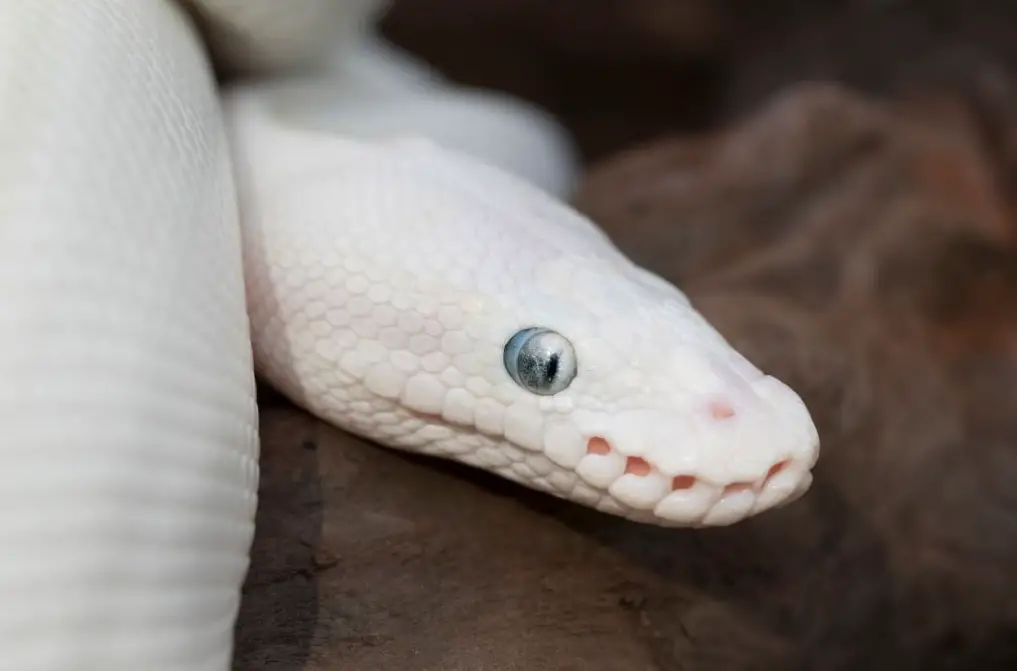
Did You Know? Leucism is different from albinism. Whereas albino morphs have no melanin or pigmentation, leucistic morphs only have a partial loss of pigmentation.
These morphs typically grow 3 – 5 feet long, with smaller males and larger females. Males usually only grow to 3 feet, while females more commonly grow to 5 feet.
There have been cases of captive females growing up to 6 feet, but this is less common.
Blue eyed leucistic morphs have the typical python shape: stocky bodies with smaller heads.
A healthy male will weigh approximately 3 Ibs. Healthy females should be approximately 4 Ibs.
Price & Availability
Ball pythons are one of the most commonly kept reptiles, which means most morphs are generally easy to find.
However, BELs are more rare because of their coloring, which requires generational breeding to produce. This means that you can’t simply breed two pythons, such as a Mojave and Phantom, but instead have to breed the byproducts of such a pairing.
As a result, this designer morph is more scarce and more expensive. Blue eyed leucistic ball pythons can cost anywhere from $500 – $1,000 depending on the breeder, lineage, and included health guarantees.
Behavior & Temperament
Ball pythons make popular pets and are often the top choice for first-time reptile owners. This reputation is well-deserved, since ball pythons are one of the most docile snakes.
With regular handling sessions and socialization, your blue-eyed lucy will easily adapt to being held.
When handling, pick them up by slipping your hand under the broad portion of their body (the first third or near the middle). Make sure to support their body as you’re lifting them.
Move slowly and make sure they’re aware of your presence. Don’t make any quick movements or jerk them out of the tank.
While holding them, maintain a firm but loose grip. Allow them to move around freely and gently redirect as necessary.
However, there are certain times you should refrain from handling your python. This includes 24 hours after rehousing them, 12 hours before and after feeding them, and during their shed cycle.
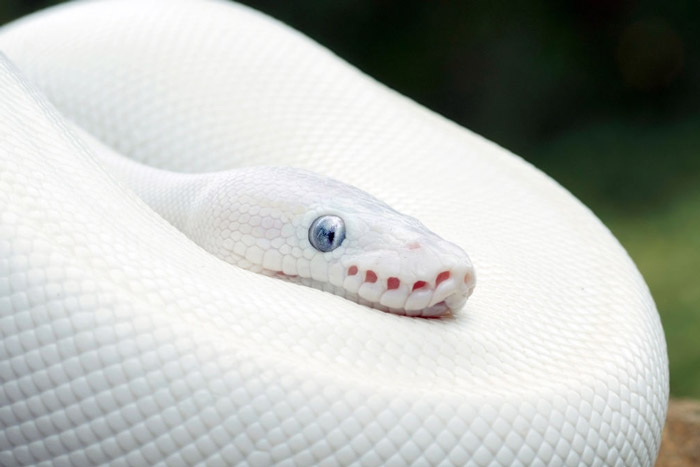
Despite their wonderful temperament, they are also one of the most shy snakes. They don’t do well in noisy or busy environments.
Lifespan
On average, ball pythons live 20 – 30 years. Because they’re a long-term commitment, you should only buy or adopt a BEL if you’re prepared to care for them for at least the next decade.
Did You Know? The record for the oldest captive ball python is 47 years!
Enclosure
Adult blue eyed leucistic pythons need at least a 40-gallon enclosure, although they’d also do well in a 50 or 60-gal.
Hatchlings and juveniles thrive in smaller environments, which make them feel more secure. A 10-gallon is appropriate for hatchlings and a 20-gallon works well for juveniles.

A good rule of thumb is to make sure your enclosure is large enough for your python to completely stretch out in.
Enclosures can be tanks, terrariums, or racks. Glass, acrylic, PVC, and plastic enclosures are all appropriate.
You’ll need at least three hides: one on the ‘hot’ side, one on the ‘cool’ side, and a humid hide.
Pro Tip: Humid hides should be closer to the ‘hot’ side or basking spot. Cool temperatures combined with moist environments will lead to respiratory infections.
Climbing materials and fake or real plants are also necessary. Additional enrichment such as leaf litter isn’t required, but will be appreciated by your python.
Appropriate substrates are cypress mulch, coconut fiber, or organic topsoils. Never use oily woods like cedar or pine.
For bioactive enclosures, make sure the substrate is intended for terrestrial species in tropical environments.
You’ll also need a water dish so that your python has 24/7 access to fresh water. Pythons like to soak, so you can either buy a dish large enough for them to curl up in or add a large secondary water feature.
Temperature & Lighting
Leucistic ball pythons need a heat gradient in their enclosure— that is, a temperature range with a ‘hot’ and ‘cool’ side so that they can thermoregulate.
The gradient should range from 75 – 85 degrees Fahrenheit. You should also have a basking spot of 85 – 90 degrees Fahrenheit.
We recommend using two thermometers to monitor your gradient. Place one on each side of the tank to ensure the ‘hot’ and ‘cool’ sides are within the correct range.
You can create this gradient by using heat bulbs, basking bulbs, and an undertank (UT) heater.
Make sure all lights are outside of your enclosure. Your snake should never be able to directly access or touch a heating element, as this can cause skin burns.
Similarly, UT heaters should be on the outside of your tank, either underneath it or on the side. If it is inside your tank, create a protective layer using reptile carpet, a hand towel, or another material.
Never use basking rocks or similar equipment, as they can burn your snake.
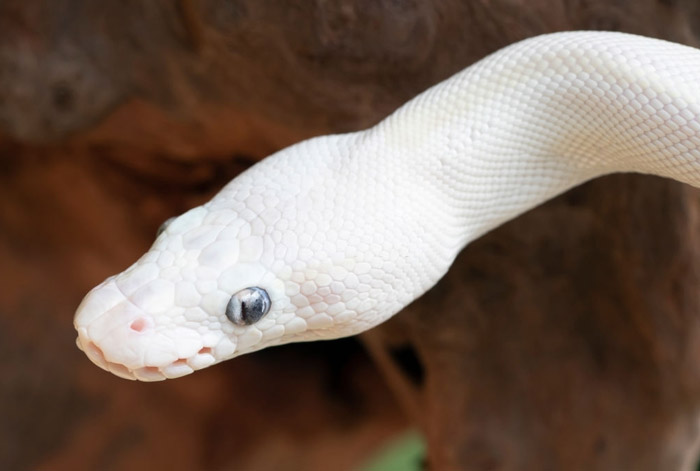
BELs benefit from a regular light cycle that mimics their natural habitat. Ideally, this means 12 hours of light during the warmer months and 8 hours of light during the cooler months.
Most heat bulbs come with daylight and nighttime options. Check the wattage before purchasing to ensure they’re not too strong or too weak to properly heat the tank.
Nighttime bulbs aren’t required. But if you choose not to use one, make sure your tank never drops below 75 degrees Fahrenheit.
If you have a bioactive setup, you’ll also need to invest in grow bulbs for your plants.
Automatic light timers and digital thermometers monitor and control the lights and heating elements, respectively. For owners with busy schedules, these are the perfect solution to creating a regular day-night cycle.
They also offer added security and protection. If the tank ever becomes too hot, the digital thermometer will turn the heating elements off until the tank drops back down to a safe temperature.
Humidity
Ball pythons need 50 – 60% humidity in their enclosures at all times.
The only area in the enclosure that should have a higher humidity is the humid hide, which should be enclosed.
Sphagnum moss is the preferred substrate for this hide because of how well it holds humidity.
Low humidity levels will cause shedding and skin problems, while high humidity levels will result in respiratory infections.
Place a hygrometer in the enclosure to monitor humidity levels.
If you’re struggling to maintain the proper humidity, consider adding a misting system or spraying the tank down at least once per day.
Diet
BELs are carnivores and should be fed a diet primarily composed of rodents, such as mice or rats. Chicks and small birds are also acceptable and offer much-appreciated food variation.
Hatchlings should be fed every 5 – 7 days and juveniles should be fed every 7 – 10 days. Adults can be fed every 10 – 14 days, depending on their preferences.
We recommend you feed your python frozen-thawed rodents. Pre-killed prey carries no diseases and won’t harm your reptile during the feeding process.
Pro Tip: It’s normal for ball pythons to become pickier during the cooler months. Don’t be alarmed if your BEL is less active and eats less often.
Potential Health Issues
There are several health issues that ball pythons are more prone to, including:
- Respiratory Infections
- Inclusion Body Disease
- Mites
- Scale Rot
The majority of these problems are related to husbandry. Keeping your python in an unclean tank or improper conditions will inevitably cause health issues.
Luckily, BELs rarely suffer from genetic issues that may morphs fall victim to, such as wobble.
During your weekly handling sessions, examine your python to ensure they’re healthy. Contact your local vet and make an appointment immediately if you suspect your snake is unwell.
Pro Tip: Just like dogs and cats, reptiles benefit from regular vet checkups. Yearly appointments with a certified reptile veterinarian is an easy way to ensure your snake is as healthy as possible.

Like all captive pets, reptiles are also at greater risk of obesity. This is especially true for ball pythons because they’re less active than many other snake breeds.
During your normal veterinary visits, make sure to ask if your BEL is within a healthy weight range. You can also weigh them at home with a regular scale.
Breeding
The only time a blue-eyed leucistic python should be housed with another ball python is for breeding purposes. Otherwise, these snakes should always be kept alone.
To breed a BEL, you’ll need to breed the offspring of two the following four morphs: Mojaves, Lessers, Butters, and Het Russos.
Each egg produced from any of these clutches has a 25% chance of being a blue-eyed lucy.
Typically, Lesser Platinums and Super Butters have the best track record producing pure white BELs.
If you already have a blue eyed lucy, you can either breed her with another BEL or one of the four morphs listed above.
To prep your female for breeding, you’ll need to reduce handling sessions and increase feeding during warm months.
When introducing a male, watch your female closely for signs of stress. If she isn’t relaxed, remove the male and wait 48 hours before trying again.
They should be kept together for roughly three days. You’ll know they’re breeding when the male curls his tail together with your female’s.
Conclusion
Blue eyed leucistics combine the best traits of ball pythons. They have all the easy care and handling of the traditional python and all of the beauty of morphs, without genetic issues that plague many other morph varieties.
BELs are perfect for keepers looking for a first-time reptile or experienced handlers looking for a new showstopper snake.
No matter if you’ve had reptiles before, blue eyed leucistic ball pythons are close to the perfect pet.
